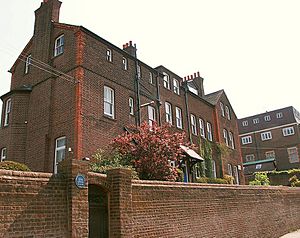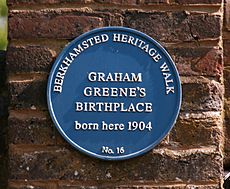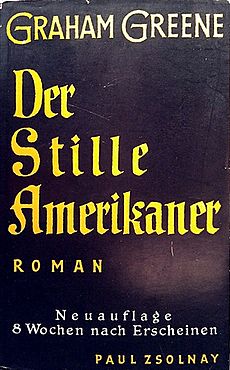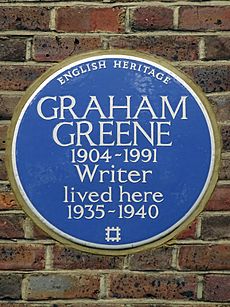Graham Greene facts for kids
Quick facts for kids
Graham Greene
|
|
|---|---|
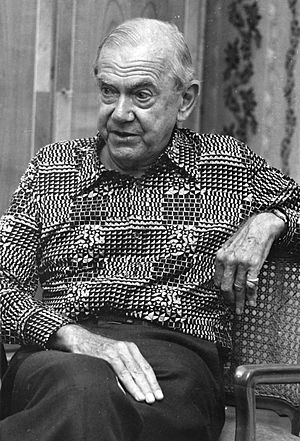
Greene in 1975
|
|
| Born | Henry Graham Greene 2 October 1904 Berkhamsted, Hertfordshire, England |
| Died | 3 April 1991 (aged 86) Vevey, Switzerland |
| Occupation | Writer |
| Alma mater | Balliol College, Oxford |
| Period | 1925–1991 |
| Genre | Literary fiction, thriller |
| Spouse | |
| Partner | Catherine Walston, Lady Walston (1946–1966) Yvonne Cloetta (1966–1991) |
| Children | 2 |
| Relatives | Raymond Greene (brother); Graham C. Greene (nephew) |
Henry Graham Greene (born October 2, 1904 – died April 3, 1991) was an English writer and journalist. Many people think he was one of the most important English novelists of the 1900s. Greene was known for both serious novels with Catholic themes and exciting thrillers, which he called "entertainments." He was nominated for the Nobel Prize in Literature many times.
Over 67 years of writing, he wrote more than 25 novels. In his books, he explored important moral and political ideas of his time. He won the 1968 Shakespeare Prize and the 1981 Jerusalem Prize.
Greene became a Catholic in 1926 before marrying Vivien Dayrell-Browning. Later in life, he called himself a "Catholic agnostic," meaning he had faith but also questions. He died in 1991 at age 86 from leukemia and was buried in Corseaux cemetery in Switzerland.
Contents
Early Life and Education (1904–1925)
Henry Graham Greene was born in 1904 in a boarding house at Berkhamsted School in Hertfordshire, England. His father was the house master there. Graham was the fourth of six children. His younger brother, Hugh, later became the head of the BBC. His older brother, Raymond, was a famous doctor and mountaineer.
His parents, Charles Henry Greene and Marion Raymond Greene, were first cousins. They came from a large, important family that owned the Greene King Brewery and included bankers and politicians. His mother was also a cousin of the famous writer Robert Louis Stevenson.
When Graham was a child, he spent his summers with his uncle, Sir Graham Greene, at Harston House in Cambridgeshire. Greene remembered learning to read there. He secretly read a book called Dixon Brett, Detective in an attic. His mother noticed and gave him The Coral Island for a train journey.
In 1910, Graham's father became the headmaster of Berkhamsted School. Graham attended the school as a student. His school friends included the journalist Claud Cockburn and the historian Peter Quennell. Greene wrote several stories for the school magazine. One of his stories was published in a London newspaper in 1921.
Studying at Oxford University
Greene went to Balliol College, Oxford, to study history. For a short time in 1922, he was part of the Communist Party of Great Britain. He hoped to visit the Soviet Union, but it didn't happen. In 1925, while he was still a student, his first book, a poetry collection called Babbling April, was published. It was not very popular.
Greene often felt sad and depressed while at Oxford and mostly kept to himself. He finished his history degree in 1925.
Writing Career and Major Works
After leaving Oxford, Greene worked as a private tutor. Then he became a journalist for the Nottingham Journal and later as a sub-editor for The Times newspaper. While working in Nottingham, he started writing letters to Vivien Dayrell-Browning. She had written to him to correct something he said about Catholic beliefs. Greene was not religious at the time. But when he thought about marrying Vivien, he decided he should learn about her faith. Greene became a Catholic on February 26, 1926. They married on October 15, 1927.
He published his first novel, The Man Within, in 1929. It was well-received, which allowed him to become a full-time writer. Greene used to divide his books into two types: "entertainments" (thrillers with deep ideas) and "novels" (more serious literary works).
His next two books, The Name of Action (1930) and Rumour at Nightfall (1932), were not successful. He later said he didn't like them. His first real success was Stamboul Train (1932). This book was chosen by the Book Society and was made into a film called Orient Express in 1934.
Even though Greene didn't like being called a "Catholic novelist," Catholic religious ideas are very important in many of his books. These include Brighton Rock, The Power and the Glory, The Heart of the Matter, and The End of the Affair. These books are often seen as great examples of Catholic novels.
Many of his works, like The Confidential Agent, The Quiet American, Our Man in Havana, The Human Factor, and his screenplay for The Third Man, also show his strong interest in international politics and spying.
To earn more money, he also worked as a freelance journalist. He wrote book and film reviews for The Spectator and helped edit the magazine Night and Day. By the 1950s, Greene was known as one of the best writers of his time.
As his career continued, the difference between his "entertainments" and "novels" became less clear. The last book Greene called an "entertainment" was Our Man in Havana in 1958. Greene also wrote short stories and plays, which were well-liked. However, he was always mainly known as a novelist. His first play, The Living Room, opened in 1953.
Michael Korda, a friend and editor, saw Greene write every day. Greene would write about 500 words in a small black notebook with a fountain pen. He would then put the notebook away for the rest of the day.
Greene was influenced by other writers like Conrad, Ford, Haggard, and Stevenson.
Travel and Spy Work
Throughout his life, Greene traveled to many distant and wild places. In 1941, his travels led to him being recruited into MI6, the British intelligence agency, by his sister, Elisabeth, who worked there. He was sent to Sierra Leone during World War II. Kim Philby, who was later found to be a Soviet spy, was Greene's boss and friend at MI6. Greene left MI6 in 1944. Greene later wrote an introduction for Philby's book about his life as a spy. As a novelist, Greene used the people he met and the places he visited in his stories.
Greene first left Europe at age 30 in 1935 for a trip to Liberia. This trip resulted in his travel book Journey Without Maps. In 1938, he traveled to Mexico to see how the government's anti-Catholic actions were affecting people. This trip was paid for by a publishing company. That journey led to two books: the factual The Lawless Roads and the novel The Power and the Glory. In 1953, the Holy Office (a Catholic group) told Greene that The Power and the Glory might harm the reputation of priests. But later, Pope Paul VI told Greene in person that he should ignore the criticism, even if parts of his novels might offend some Catholics.
Greene first visited Haiti in 1954, where his novel The Comedians (1966) is set. Haiti was then ruled by the dictator François Duvalier, known as "Papa Doc." Greene often stayed at the Hotel Oloffson in Port-au-Prince. In the late 1950s, to get ideas for his novel A Burnt-Out Case (1960), Greene traveled around Africa. He visited several leper colonies in the Congo Basin and the British Cameroons. During this trip, he met Andrée de Jongh, a Belgian resistance leader from WWII.
In 1957, Greene helped Fidel Castro's rebels in Cuba. He secretly carried warm clothes for them while they were hiding in the hills. Greene was fascinated by strong leaders and later met Castro. After one visit, Castro gave Greene a painting he had made. Greene later had some doubts about Castro's rule, saying in 1983 that he admired Castro's courage but questioned his strict control.
Publishing Work
Between 1944 and 1948, Greene worked as a director at a publishing company called Eyre & Spottiswoode. He was in charge of finding new fiction books. He also worked as a director at The Bodley Head from 1957 to 1968.
Personal Life and Health
Greene was not religious at first, but he became a Catholic in 1926 before marrying Vivien Dayrell-Browning. They married on October 15, 1927, and had two children, Lucy (born 1933) and Francis (born 1936).
Greene separated from his family in 1947. Vivien did not want to divorce him because of their Catholic beliefs, so they remained married until Greene's death in 1991.
Greene lived with bipolar disorder, which caused him to have periods of deep sadness. This condition greatly affected his writing and his personal life. He once wrote to his wife that he had "a character profoundly antagonistic to ordinary domestic life," and that "unfortunately, the disease is also one's material." The writer William Golding said Greene was great at showing the thoughts and worries of people in the 1900s.
Later Years and Death
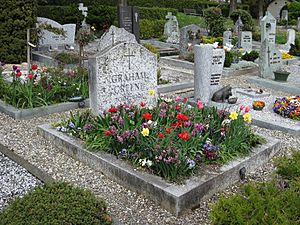
In 1966, Greene decided to leave Britain and moved to Antibes, France. He wanted to be closer to Yvonne Cloetta, a woman he had known since 1959. Their relationship lasted until his death. In 1973, he had a small, uncredited acting part in the film Day for Night. In 1981, Greene received the Jerusalem Prize, which is given to writers who focus on individual freedom in society.
He spent his last years in Vevey, Switzerland, near Lake Geneva. This was the same town where Charlie Chaplin lived, and Greene often visited him. His book Doctor Fischer of Geneva or the Bomb Party (1980) has ideas influenced by his life there. He had stopped going to church in the 1950s, but in his final years, he started receiving Catholic sacraments again from a priest who became his friend.
In one of his last writings, a pamphlet called J'Accuse: The Dark Side of Nice (1982), Greene wrote about a legal problem involving his family in Nice, France. He claimed that organized crime was common in Nice because city officials protected corrupt judges and police. Greene lost a lawsuit over these claims. However, after his death in 1994, the former mayor of Nice was put in prison for corruption, which showed Greene had been right.
In 1986, Greene was given Britain's Order of Merit, a special honor. He died of leukaemia in 1991 at the age of 86 and was buried in Corseaux cemetery.
Writing Style and Themes
Greene first divided his fiction into two types: thrillers, which he called "entertainments," and more serious "novels." His thrillers, like The Ministry of Fear, often had deep philosophical ideas. His novels, like The Power and the Glory, were the works he believed would make his literary reputation.
Over time, Greene and his readers found it harder to tell the difference between his "entertainments" and "novels." The last book he called an "entertainment" was Our Man in Havana in 1958. Later, when his collected works were published, all his books were simply called "novels."
Greene's writing was very "cinematic," meaning it was easy to imagine as a movie. Most of his novels, plays, and short stories have been made into films or TV shows. The Internet Movie Database lists 66 titles based on his work. Some novels were filmed more than once, like Brighton Rock and The Quiet American. Greene was nominated for an Academy Award for his screenplay for the 1948 film The Fallen Idol, based on his own short story. In 1949, he wrote the screenplay for the classic film The Third Man.
In 2009, a newly found novel by Greene, called The Empty Chair, began to be published. He wrote it when he was 22.
Greene's writing style was described as very clear and direct. He focused on telling the story and keeping the reader interested. His novels often have religious themes. He believed that writers like Virginia Woolf and E. M. Forster had lost a sense of religion, which made their characters seem less real. Greene thought that novels needed to show the inner struggles of people's souls, including ideas of good and evil, sin, and divine grace.
Suffering and unhappiness are common in Greene's stories. Catholicism is often shown against a background of human evil, sin, and doubt. V. S. Pritchett praised Greene for being the first English novelist since Henry James to truly show the reality of evil. Greene focused on the inner lives of his characters—their thoughts, feelings, and spiritual journeys. His stories are often set in poor, hot, and dusty tropical places like Mexico, West Africa, Vietnam, Cuba, Haiti, and Argentina. These settings led to the term "Greeneland" to describe his typical story locations.
His later writings showed less focus on strict Catholic themes. He became more interested in human perspectives and openly criticized some traditional Catholic teachings.
In his later years, Greene strongly criticized American imperialism (when America tried to control other countries). He supported the Cuban leader Fidel Castro, whom he had met. Years before the Vietnam War, he wrote about the dangers of the idealistic but arrogant beliefs of the character in The Quiet American. This character's certainty in his own goodness caused disaster for the Vietnamese. Greene believed that "Conservatism and Catholicism should be... impossible bedfellows."
In 1949, a magazine held a contest for funny imitations of Greene's writing style. He entered under a fake name and won second prize!
Legacy and Recognition
Graham Greene is seen as a very important novelist of the 20th century. Before Greene died, the writer John Irving called him "the most accomplished living novelist in the English language." The novelist Frederick Buechner said Greene's novel The Power and the Glory had a "tremendous influence." By 1943, Greene was known as the "leading English male novelist of his generation." When he died in 1991, he was famous for both his serious novels about Catholicism and his exciting suspense stories.
Greene was nominated for the Nobel Prize in Literature several times during his lifetime. In 1961, 1966, and 1967, he was among the final three candidates for the prize. However, he never won it.
He received several literary awards for his novels. These include the 1941 Hawthornden Prize for The Power and the Glory and the 1948 James Tait Black Memorial Prize for The Heart of the Matter. He also won the 1968 Shakespeare Prize and the 1981 Jerusalem Prize. In 1986, he was awarded Britain's Order of Merit.
The Graham Greene International Festival is an annual four-day event. It includes talks, films, readings, and workshops about his works. It is organized by the Graham Greene Birthplace Trust and takes place in his hometown of Berkhamsted, near his birthday (October 2). The festival aims to encourage interest in and study of Graham Greene's books.
He is the subject of the 2013 documentary film, Dangerous Edge: A Life of Graham Greene. His short story "The Destructors" was featured in the 2001 film Donnie Darko.
Select Works
- The Man Within (1929)
- Stamboul Train (1932)
- It's a Battlefield (1934)
- England Made Me (1935)
- A Gun for Sale (1936)
- Journey Without Maps (1936)
- Brighton Rock (1938)
- The Lawless Roads (1939)
- The Confidential Agent (1939)
- The Power and the Glory (1940)
- The Ministry of Fear (1943)
- The Heart of the Matter (1948)
- The Third Man (1949) (novella)
- The End of the Affair (1951)
- Twenty-One Stories (1954) (short stories)
- Loser Takes All (1955)
- The Quiet American (1955)
- The Potting Shed (1956)
- Our Man in Havana (1958)
- A Burnt-Out Case (1960)
- In Search of a Character: Two African Journals (1961)
- The Comedians (1966)
- Travels with My Aunt (1969)
- A Sort of Life (1971)
- The Honorary Consul (1973)
- The Human Factor (1978)
- Ways of Escape (1980)
- Doctor Fischer of Geneva (1980)
- Monsignor Quixote (1982)
- Getting To Know The General: The Story of an Involvement (1984)
- The Tenth Man (1985)
- The Last Word (1990) (short stories)
See also
 In Spanish: Graham Greene para niños
In Spanish: Graham Greene para niños


